Article: The Ultimate Guide to Pet Food Storage Solutions
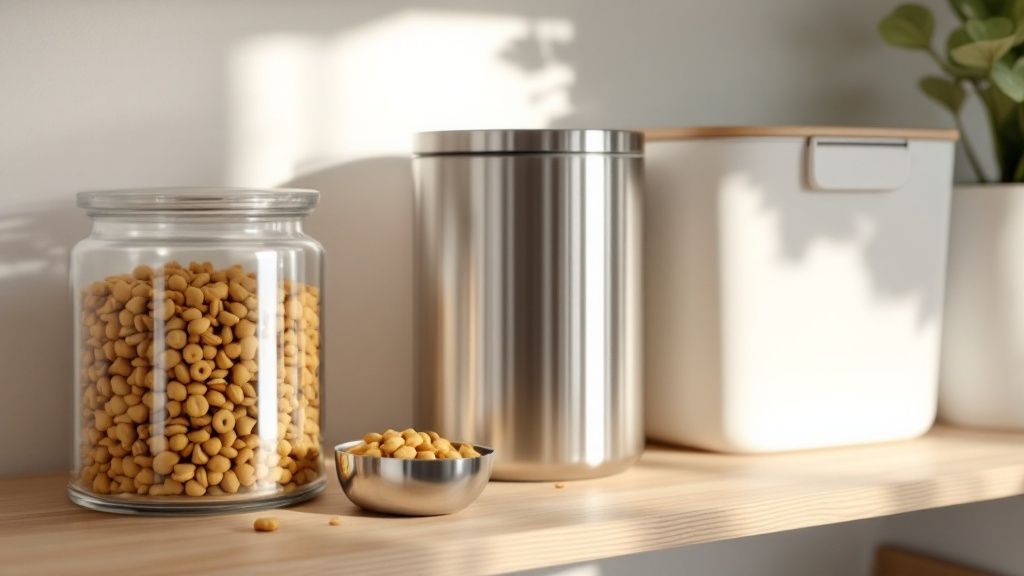
The Ultimate Guide to Pet Food Storage Solutions
Here at Wonders Emporium Shop, we think of ourselves as your personal concierge, helping you find the absolute best for your furry family. Let's have a real conversation about something we both care deeply about: keeping our pets healthy and happy, starting with what's in their bowl.
Proper pet food storage solutions are about so much more than just keeping the pantry looking neat. It's a simple, daily habit that has a huge impact on the freshness, safety, and nutritional punch of every single meal you serve. Honestly, it’s one of the most important things you can do for your pet.
Why Pet Food Storage Is Key to Your Pet's Health
We've all done it—rolled down the top of a giant kibble bag, maybe thrown a chip clip on it, and called it a day. But that open bag is an open invitation for problems. From the moment it's exposed to air, the good stuff inside starts to break down.
Essential nutrients fade, healthy fats can go rancid, and that delicious aroma your pet loves starts to disappear.
Storing pet food correctly isn't just for convenience. It's the only way to lock in the nutrition your pet needs and protect them from the health risks of spoiled, contaminated, or pest-ridden food.
The Dangers of an Open Bag
Leaving pet food in its original, unsealed bag is a bit like leaving a box of cereal open on the counter—it's just not going to stay fresh. This exposure kicks off a chain reaction of issues that the right storage solution is designed to stop in its tracks.
- Nutrient Degradation: Vitamins and fats are fragile. When they hit the air and light, they start to degrade, which means your pet isn't getting the full nutritional benefit you paid for.
- Pest Infestation: An open bag is a dinner bell for insects and rodents. These unwanted guests can contaminate the food with bacteria and waste, which is the last thing you want in your pet's bowl.
- Spoilage and Mold: Air and humidity are the perfect recipe for growing mold and nasty bacteria like Salmonella. This poses a serious health threat to your four-legged friend.
- Loss of Freshness: Just like our own snacks, kibble goes stale when it’s left out. A stale meal is a lot less exciting for your pet, and they might even turn their nose up at it.
To help you get a quick lay of the land before we dig into the details, here’s a look at some of the most popular ways to store pet food.
Quick Guide to Pet Food Storage Options
This table sums up the common storage solutions out there. Think of it as a cheat sheet to help you quickly narrow down the best fit for your home and your pet's needs.
| Storage Type | Best For | Key Benefit | Common Material |
|---|---|---|---|
| Airtight Plastic Bin | Storing large bags of dry kibble conveniently and affordably. | Excellent seal against air and pests, keeping food fresh. | BPA-Free Plastic |
| Stainless Steel Canister | Pet owners who prioritize durability and hygiene. | Non-porous, easy to sanitize, and prevents odor absorption. | Stainless Steel |
| Glass Jar | Smaller pets or storing treats in a stylish, visible way. | Non-reactive material that ensures purity and freshness. | Glass |
| Original Bag with Clip | A temporary, short-term solution in a pinch. | Better than nothing, but offers minimal protection. | N/A |
Now that you have the basics, this guide will walk you through everything else you need to know. We want you to feel confident you're making the absolute best choice for your best friend.
The Hidden Risks of Improper Food Storage
It’s something we do every day without a second thought: scooping out our pet’s food. But how that food is stored between meals can make a huge difference to your furry friend's health. Let's be honest, it’s easy to just roll down the top of the bag and call it a day, but this simple habit can have some nasty consequences. A dedicated storage solution isn't just about keeping things neat; it's a vital part of their well-being.
Think of an open bag of kibble like a bag of chips left on the counter overnight. You know what happens—they get stale, lose their crunch, and just taste… off. The exact same thing, a process called oxidation, happens to your pet’s food when it’s exposed to everyday elements like air, light, moisture, and heat.
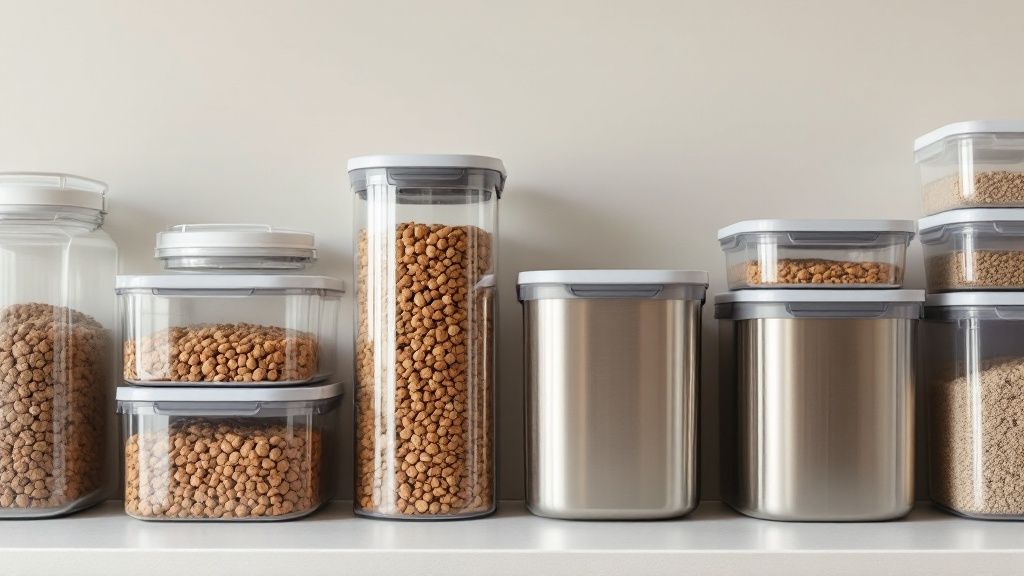
How Freshness Fades
The moment pet food is exposed to the air, a chemical breakdown kicks off. The healthy fats, which are so important for your pet’s skin, coat, and energy levels, begin to go rancid. Not only does this make the food taste bad, but it can also lead to an upset stomach.
At the same time, all those essential vitamins and minerals that the manufacturer so carefully balanced start to break down and lose their power. The high-quality nutrition you paid for slowly evaporates, meaning your pet isn't getting the full benefit from their meals. Improper pet food storage solutions basically shortchange your pet's health.
The Threat of Contaminants
Going stale is one thing, but poor storage can open the door to much more serious health hazards. An unsealed or poorly sealed bag is an invitation for moisture, and moisture is the number one ingredient for contamination.
- Bacterial Growth: A little humidity creates the perfect breeding ground for nasty bacteria like Salmonella and E. coli. These aren't just a threat to your pet; they can easily be transmitted to the humans in your family, too.
- Mold and Mycotoxins: Mold spores are literally everywhere, and a damp, dark bag of kibble is their idea of a five-star hotel. Some molds produce dangerous toxins called aflatoxins, which can cause liver damage and are especially toxic to dogs, even in tiny amounts.
- Pest Infestations: An open food source is a dinner bell for pests like rodents, ants, and pantry moths. These unwelcome guests don't just steal food; they contaminate it with their waste, bringing a whole host of other diseases with them.
Your pet's food bowl should be a source of nourishment, not a potential health risk. Proper storage is your first line of defense against invisible threats like bacteria, mold, and rancidity.
Protecting Your Pet and Your Peace of Mind
Once you understand these risks, you'll never look at that half-open bag of kibble the same way again. This isn't just about keeping the kitchen tidy; it's about actively managing your pet's health. By investing in a quality, airtight container, you’re taking a critical step to protect the integrity of their food and their safety.
This commitment to safety is something we care deeply about at Wonders Emporium Shop. We believe providing the best care starts with the basics. You want to ensure every scoop you serve is as fresh, nutritious, and safe as the day you first opened the bag.
Choosing the right storage solution isn't just a practical choice—it's an act of love. It guarantees that the food you so carefully selected continues to support your pet's vibrant health from the first bite to the last. As a family-run business under Boricua Innovations LLC, we're committed to helping you provide that exceptional care every single day.
Now, let’s explore how to choose the perfect container to safeguard that precious cargo.
How to Choose the Right Pet Food Container
Picking the right container for your pet's food is a lot like choosing a home for their meals. It needs to be safe, secure, and most importantly, keep everything inside fresh and delicious. Now that you know the dangers of storing food incorrectly, let's walk through the best options so you can choose with confidence.
Decoding Container Materials
The material of your container is everything. It determines how durable it is, how easy it is to clean, and how well it protects the food from going stale. Each one has its own benefits, and the best choice really comes down to your priorities.
- BPA-Free Plastic: These are the reliable workhorses of pet food storage. They're lightweight, affordable, and perfect for holding large bags of kibble. The most important thing is to make sure it's labeled BPA-free, so no harmful chemicals get into your pet's dinner.
- Durable Stainless Steel: If hygiene and long-term use are at the top of your list, you can't go wrong with stainless steel. It’s non-porous, which means it won’t soak up those funky oils and smells from the kibble. This keeps it from getting that gross, rancid smell over time. Plus, it’s a breeze to clean and sanitize.
- Non-Porous Glass: Glass containers are a great-looking and effective option, especially for treats or food for smaller pets. Just like stainless steel, glass is non-porous and won't leach any chemicals. The clear view also means you'll know exactly when it's time to restock.
It’s no surprise that pet owners are getting serious about storage. The global dog food container market hit about USD 1.33 billion in 2024 and is expected to jump to USD 2.41 billion by 2034. This really shows how much people care about keeping their pet's food safe and fresh in high-quality, eco-friendly containers.
The Airtight Seal: The Unsung Hero
If there’s one feature you absolutely can't skip, it’s an airtight seal. This is your number one defense against stale, unappetizing food. Think of it as a force field that locks out freshness-killers like air and moisture while sealing in all the good stuff—the aroma, taste, and nutrients.
An airtight seal does more than just keep food from going stale. It creates a secure barrier that prevents pests from getting in and stops harmful bacteria and mold from growing. It is the cornerstone of effective pet food storage.
Even the best container material is useless without a good seal. When you're shopping, look for strong locking clips, silicone gaskets, or screw-on lids that create a true seal.
This infographic says it all—a proper seal makes a huge difference.
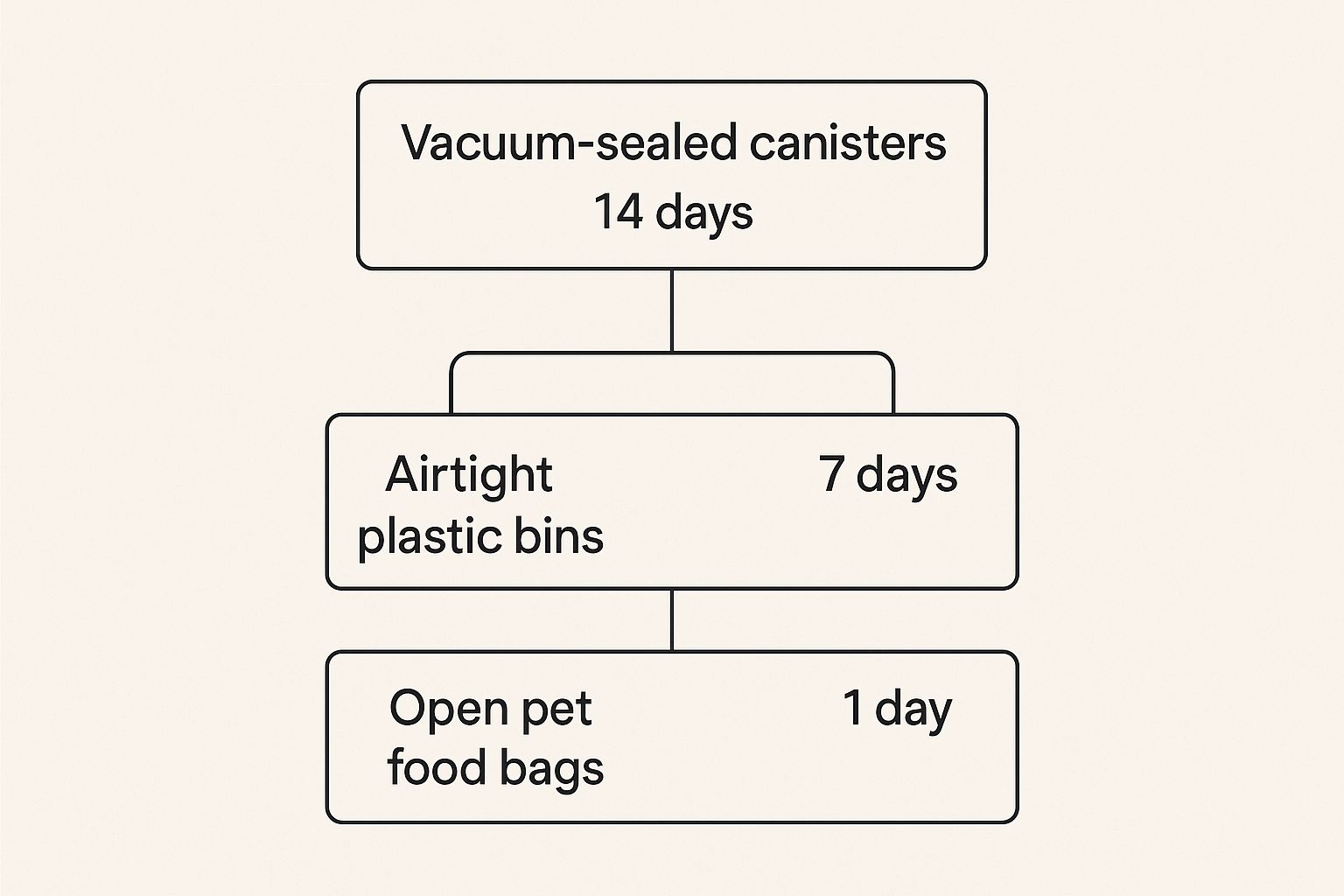
As you can see, an airtight seal can extend the life and nutritional value of your pet's food by weeks.
Sizing It Up Just Right
Goldilocks had the right idea—not too big, not too small. The size of your container matters more than you’d think. If you buy a massive container for a tiny pet, that food is going to sit around for months, losing its freshness long before your pet can finish it.
Here’s a simple rule of thumb:
- Calculate Consumption: Figure out how much food your pet eats in about 4-6 weeks. That's the sweet spot for using up an open bag of kibble.
- Match the Bag: Pick a container that can comfortably hold the entire bag of food you usually buy.
- Avoid Overbuying: It’s tempting to buy in bulk to save a few bucks, but it’s better for your pet's health to buy smaller bags that you can use up within a month or so.
Thinking about freshness and proper portions isn't just for dogs and cats. For instance, a high-tech solution like the X Clear Automatic Fish Feeder shows how technology can help manage feeding schedules and maintain food quality, even for fish. The principle is the same for all our animal friends.
Choosing eco-friendly materials is another great way to show you care. Many modern containers are made from sustainable or recycled materials, which is a win for your pet and the planet. For more ideas on earth-conscious pet care, check out our guide on eco-friendly pet products. At Wonders Emporium Shop, we believe in quality and care, reflecting our values rooted in Puerto Rican pride and exceptional customer support. Our business, owned and operated by Boricua Innovations LLC, is here to help you make choices you can feel good about.
Best Storage Practices for Every Type of Pet Food
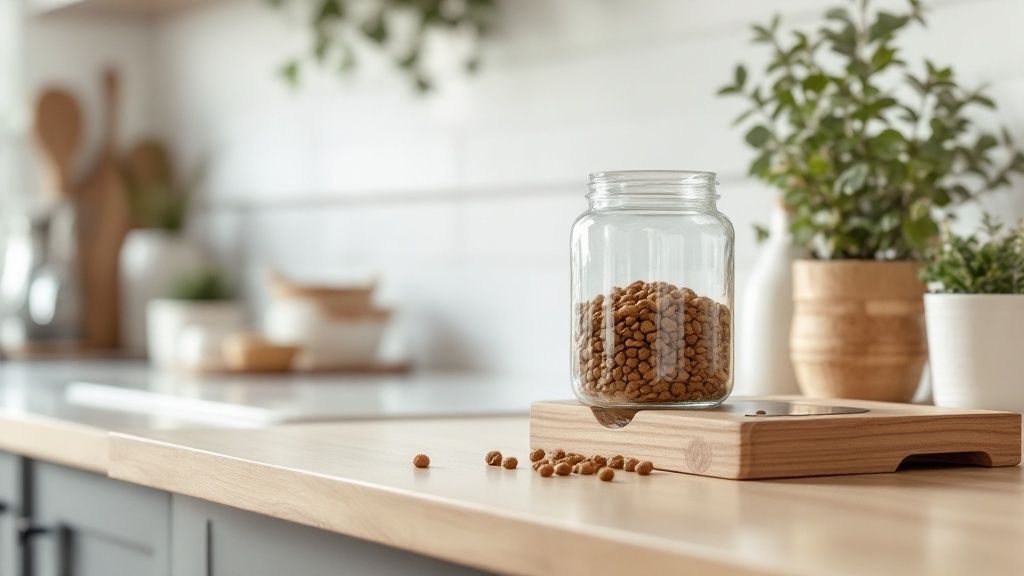
Just like the food we eat, not all pet food is created equal. Each type—from crunchy kibble to savory wet food—has its own unique storage needs to stay safe and delicious. Getting this right is one of the easiest ways to ensure you're giving your furry companion the very best at every meal. Let’s walk through the proper storage solutions for each kind of food, so every bite is as fresh as the first.
This kind of attention to detail is becoming the new normal for pet owners. The global pet food market was valued at USD 128.21 billion in 2024 and is expected to climb to USD 185.54 billion by 2030. That growth is fueled by owners like us choosing higher-quality, premium foods. Proper storage is simply about protecting that investment.
Mastering Dry Kibble Storage
Dry kibble is a go-to for many pet parents because it's so convenient, but keeping it fresh takes a little more than just dumping it in a bin. While it’s tempting to pour the whole bag into a new container, experts actually recommend against it.
The gold standard method is to keep the kibble in its original bag and place that entire bag inside an airtight container. Here’s why this small step makes a huge difference:
- Fat Barrier Protection: The original packaging has a special liner designed to keep the fats and oils from seeping out and turning rancid.
- Essential Information: That bag has the "best by" date, lot number, and barcode. In the rare event of a product recall, this information is absolutely crucial.
- Freshness Seal: Keeping it in the bag adds an extra layer of protection against air and moisture, working hand-in-hand with your container's seal.
Think of the original bag as the food's protective inner layer and the airtight container as its sturdy outer shell. Together, they create the ultimate defense against staleness and contamination.
Handling Wet and Canned Food
Wet food is a fantastic source of hydration and often a big hit with picky eaters. Since it usually comes in single-serving cans, storage is pretty straightforward, but you have to act fast once it’s opened.
The moment you open a can of wet food, any leftovers need to go straight into the fridge. To keep it fresh and stop the smell from taking over your refrigerator, just follow these simple steps:
- Cover It Securely: A snug-fitting plastic or silicone can cover is perfect for this. If you don’t have one, plastic wrap or transferring the food to a small airtight container works just as well.
- Refrigerate Promptly: Get the covered food into a refrigerator that’s set to 40°F (4°C) or below.
- Use Within a Few Days: To be safe, plan on using up any leftover wet food within three to five days.
If you're looking for more great tips on keeping your pantry and fridge in top shape, you might like our guide on kitchen organization hacks.
Special Care for Raw and Fresh-Frozen Diets
Raw and fresh-frozen diets are becoming more popular for their nutritional benefits, but they require the strictest storage rules of all. The top priority here is safety—preventing bacterial growth and cross-contamination is non-negotiable.
- Strict Temperature Control: Always keep raw food frozen solid. Only thaw what you need for the next day or two, and always thaw it in the refrigerator—never on the countertop.
- Prevent Cross-Contamination: Treat raw pet food with the same caution you would raw meat for your own meals. Use separate utensils and cutting boards, and wash your hands, bowls, and any surfaces it touches with hot, soapy water.
- Refrigerate After Thawing: Once thawed, store the food in an airtight container in the fridge and use it up within two to three days.
Making sure you're storing every type of food correctly is a key part of responsible pet ownership. To dive deeper, you can learn more about optimal pet food storage for various types of food. Here at Wonders Emporium Shop, we’re committed to helping you make those choices with confidence.
Maintaining Your Storage for Lasting Freshness
Getting a quality storage container is a fantastic first step. But like any tool in your home, it needs a bit of upkeep to do its job right. Proper maintenance turns your container into a fortress of freshness, keeping every meal just as nutritious as the day you opened the bag.
Think of it this way: you wouldn't just keep topping off your own Tupperware without washing it, right? The same logic applies here. Over time, oils and crumbs from kibble build up, go rancid, and can contaminate the fresh food you add. This simple routine is the secret to getting the most out of your pet food storage solutions.
The Essential Cleaning Checklist
To keep things easy, we’ve put together a quick checklist for maintaining your storage containers. Running through these steps every time you finish a bag of food will stop gunk from building up and guarantee a clean slate for every meal.
- Empty and Wipe: Once the container is empty, give it a quick wipe to get rid of any leftover crumbs or dust.
- Wash Thoroughly: Use warm water and a gentle, non-toxic soap—just like you would with your own dishes.
- Rinse Well: This is important! Make sure every bit of soap is rinsed away. Any residue could upset your pet’s stomach.
- Dry Completely: This is the most crucial step. Even a little bit of moisture is an open invitation for mold and bacteria. Let it air-dry completely or use a clean towel before you even think about refilling it.
This kind of mindful pet care is becoming a huge priority for owners everywhere. The global pet care industry is booming, and we're seeing a shift as younger generations like Gen Z drive demand for products that are both convenient and sustainable—including well-designed, easy-to-clean storage. You can dive deeper into these trends in this analysis from the Pet Food Industry.
Mastering the First-In, First-Out Method
Want to make sure your pet is always eating the freshest food possible? There’s a simple inventory trick called the “first in, first out” (FIFO) method. It sounds a bit technical, but it’s incredibly straightforward.
The FIFO method just means you use up all the old food before adding the new. This stops kibble from getting stuck at the bottom of the container, where it can slowly go stale.
When you buy a new bag, resist the urge to just dump it on top of what’s left. Instead, wait until the container is empty, give it a quick clean, and then pour in the new bag. It’s a small habit that makes a huge difference in freshness.
Finding the Perfect Storage Spot
Where you keep your pet’s food is just as important as what you keep it in. You need to protect it from the elements. The golden rule is to find a spot that is cool, dry, and dark.
A pantry, a cool closet, or a kitchen cabinet are all great options. These places shield the food from direct sunlight, which can destroy vitamins, and protect it from temperature swings that cause condensation.
There's one spot you should definitely avoid: the garage. Garages get brutally hot in the summer and freezing cold in the winter. These temperature extremes are terrible for pet food, breaking down nutrients and creating the perfect breeding ground for mold. By choosing a stable, indoor location, you’re adding one more layer of protection for your pet’s health.
Common Pet Food Storage Questions Answered
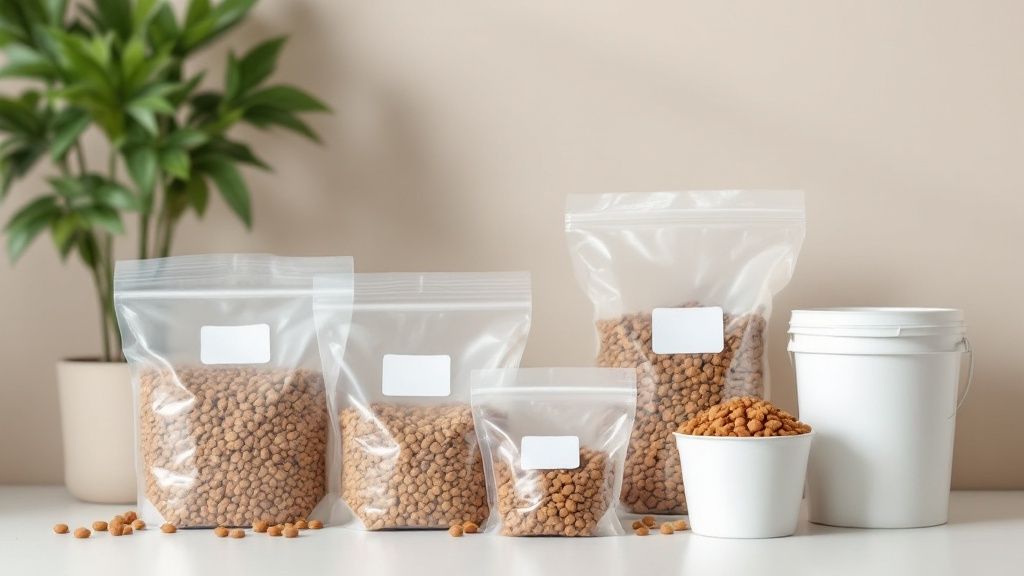
Navigating the world of pet care can bring up a lot of questions. As your personal guide in all things pet, we’ve gathered the most common queries we hear about pet food storage solutions to give you clear, helpful answers and complete peace of mind.
How Long Does Dry Pet Food Last Once Opened?
This is easily one of the most frequent questions we get, and for a good reason! Once you break the seal on that bag of kibble, the clock officially starts ticking on its freshness.
The culprit is a process called oxidation—when the food is exposed to air, the fats and vitamins inside begin to break down. To make sure your pet gets the best taste and nutritional punch, you should aim to use an entire bag of dry food within 4 to 6 weeks of opening it.
Storing it properly in an airtight container can definitely slow this process down. But remember, the "best by" date on the original packaging is always your most important guideline.
Should I Pour Kibble Directly Into a Container?
While it might seem way easier to just dump the kibble into your storage bin, experts actually advise against it. The best practice is to keep the food in its original bag and then place the entire bag inside your airtight container.
There are a couple of key reasons for doing it this way:
- The Bag is a Barrier: The original packaging is designed with a special lining that acts as a fat barrier. This helps keep the oils in the food from going rancid too quickly.
- Critical Information: The bag contains the "best by" date, barcode, and lot number. This information is absolutely essential if there's ever a product recall.
Keeping the bag gives you an extra layer of protection and makes sure you have all the necessary product details right at your fingertips.
Is It Safe to Store Pet Food in a Garage?
Storing pet food in a garage, shed, or any outdoor area is generally not a great idea. These spaces are notorious for wild temperature swings and high humidity.
Extreme heat can speed up how fast nutrients break down, while humidity creates the perfect breeding ground for mold and harmful bacteria. Even the best airtight container can't fully protect food from prolonged exposure to these harsh conditions.
The ideal storage spot is a cool, dry, and dark place inside your home, like a pantry or a closet. This stability protects the food’s nutritional integrity and keeps it safe from spoilage.
If you find yourself needing to store food long-term, you might be interested in the convenience of our Wonders Emporium Shop pet subscription boxes, which deliver fresh food right when you need it.
What Are the Signs My Pet's Food Has Gone Bad?
Your own senses are your best tools for spotting spoiled food. If you're ever on the fence about the freshness of your pet’s kibble or wet food, look for these tell-tale signs.
Common indicators of spoilage include:
- An Off Smell: If the food smells sour, musty, or just plain rancid, it has likely gone bad.
- Visible Mold: Any sign of mold, no matter how small, means the entire batch should be tossed.
- Moisture or Clumping: Dry food should be just that—dry. Any dampness or clumping is a red flag that moisture has gotten in.
- Signs of Pests: Be on the lookout for insects, larvae, or evidence of rodents.
Finally, trust your pet. If they suddenly turn their nose up at a food they usually devour, its freshness might be the problem. Here at Wonders Emporium Shop, we believe your pet's safety is the top priority. When in doubt, it’s always safest to throw it out.
